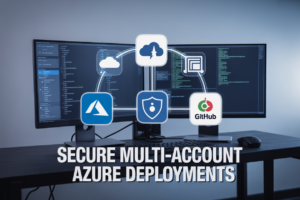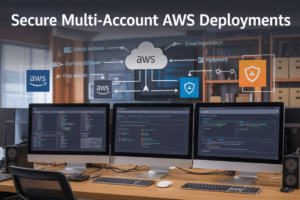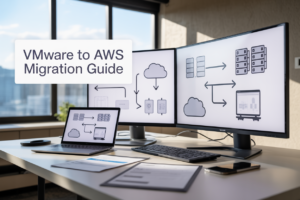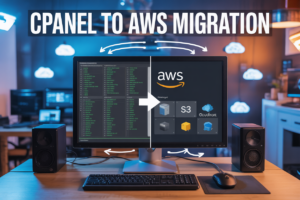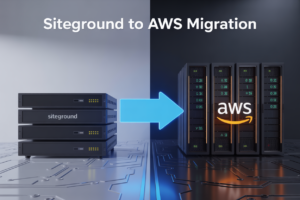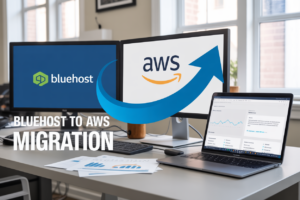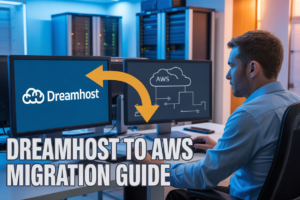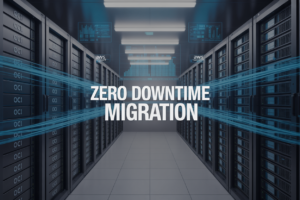Managing QuickSight IP restrictions manually becomes a nightmare when your team grows or remote workers change locations frequently. This guide shows data engineers, DevOps teams, and AWS administrators how to automate QuickSight access control using AWS Lambda, eliminating the tedious process of updating IP whitelists by hand.
You’ll discover why AWS Lambda QuickSight integration transforms security management from a daily headache into a hands-off system. We’ll walk through building an automated IP whitelist that adapts to your team’s changing needs, covering the essential Lambda fundamentals that make QuickSight security automation possible.
You’ll also learn to implement dynamic IP management logic that updates restrictions in real-time, plus explore advanced customization options that fit your organization’s specific security requirements.
Understanding QuickSight IP Restrictions and Security Challenges
Current manual IP management limitations and scalability issues
Managing AWS QuickSight IP restrictions manually creates significant operational bottlenecks that worsen as organizations grow. Teams spend hours updating static IP whitelists every time remote workers change locations or new offices come online. This tedious process involves navigating QuickSight console menus, validating IP ranges, and coordinating with multiple stakeholders. Large enterprises with hundreds of users across different regions face exponential complexity when managing QuickSight access control through traditional methods. The administrative burden increases dramatically during business expansions, mergers, or when implementing hybrid work policies. Manual processes also introduce human errors that can accidentally block legitimate users or leave security gaps open.
Security risks of static IP whitelist configurations
Static IP whitelists in QuickSight create false security assumptions that become dangerous over time. Organizations often maintain outdated IP ranges from former employees, contractors, or decommissioned office locations, creating unnecessary attack surfaces. These stale entries in QuickSight IP restrictions can be exploited by malicious actors who gain access to previously authorized networks. Dynamic IP environments common with cloud services, VPNs, and mobile workforces make static configurations particularly vulnerable. Security teams struggle to maintain visibility into which IP addresses actually represent current legitimate users versus potential threats. Regular audits become nearly impossible without automated tracking, leading to accumulated security debt that compromises overall QuickSight security posture.
Business impact of access delays and administrative overhead
Access delays from manual QuickSight IP restrictions directly impact business productivity and decision-making speed. Sales teams miss critical opportunities when they can’t access dashboards from client sites or conferences. Executive leadership faces delayed insights during strategic meetings when their current location isn’t pre-approved in the IP whitelist. The administrative overhead of managing these restrictions diverts IT resources from higher-value projects and innovation initiatives. Help desk tickets pile up as users request emergency access approvals, creating cascading delays across departments. Organizations often resort to overly permissive configurations to avoid business disruptions, inadvertently compromising their AWS QuickSight security standards. This reactive approach costs companies both in terms of security posture and operational efficiency.
AWS Lambda Fundamentals for QuickSight Automation
Lambda function architecture and event-driven processing
AWS Lambda provides the perfect foundation for automating QuickSight security management through its event-driven, serverless architecture. Lambda functions respond automatically to triggers like CloudWatch Events, API Gateway requests, or S3 bucket changes, making them ideal for dynamic IP restriction management. The stateless nature of Lambda ensures consistent execution while automatically scaling based on demand. Functions can process multiple IP update requests simultaneously without requiring complex infrastructure management. Event-driven processing allows real-time responses to security events, user login attempts, or scheduled maintenance windows. Lambda’s built-in retry mechanisms and error handling capabilities ensure reliable execution of critical security operations. The serverless model eliminates server management overhead while providing millisecond response times for IP restriction updates.
Integration capabilities with QuickSight APIs
Lambda functions integrate seamlessly with QuickSight APIs through the AWS SDK, enabling comprehensive access control automation. The QuickSight API supports programmatic management of IP restrictions, user permissions, and account-level security settings through RESTful endpoints. Lambda can leverage IAM roles for secure API authentication while maintaining principle of least privilege access. Functions can retrieve current IP allowlists, compare against dynamic sources like corporate VPN endpoints, and update restrictions automatically. API integration supports batch operations for efficient processing of large IP ranges and complex rule sets. Real-time synchronization between multiple data sources ensures consistent security policies across distributed teams. Lambda can also integrate with third-party IP intelligence services to enhance security decision-making processes.
Cost benefits of serverless IP management solutions
Serverless QuickSight IP management delivers significant cost advantages compared to traditional always-on infrastructure solutions. Lambda’s pay-per-execution model means you only pay for actual security processing time, typically measured in milliseconds rather than hours. No upfront infrastructure costs or ongoing server maintenance expenses reduce total ownership costs by up to 80% compared to EC2-based solutions. Automatic scaling eliminates over-provisioning waste while ensuring adequate capacity during peak security events. The serverless approach reduces operational overhead by eliminating patching, monitoring, and capacity planning requirements. Lambda’s sub-second execution times for IP updates minimize business disruption while maintaining robust security posture. Cost predictability improves through usage-based pricing models that scale linearly with actual security management needs.
Setting Up Your Automated IP Restriction System
Required AWS permissions and IAM role configurations
Your Lambda function needs specific permissions to interact with QuickSight APIs and manage IP restrictions effectively. Create an IAM role with quicksight:UpdateIpRestriction and quicksight:DescribeIpRestriction permissions for AWS QuickSight security automation. Add logs:CreateLogGroup and logs:PutLogEvents for CloudWatch logging. The role should also include VPC access permissions if your Lambda runs inside a VPC for enhanced AWS Lambda QuickSight integration security.
Lambda function deployment and environment setup
Deploy your automated IP whitelist Lambda function using AWS SAM or CloudFormation templates for consistent QuickSight access control deployment. Configure environment variables for your QuickSight account ID, AWS region, and IP source endpoints. Set the runtime to Python 3.9 or Node.js 18.x with at least 512MB memory allocation. Enable dead letter queues and configure retry policies to handle temporary API failures during dynamic IP management AWS operations. Package your function with required dependencies for seamless QuickSight IP filtering Lambda execution.
QuickSight API connection and authentication methods
Establish secure connections to QuickSight APIs using AWS SDK with IAM role-based authentication rather than hardcoded credentials. Your Lambda function authenticates automatically through the execution role, eliminating credential management overhead. Configure boto3 clients with proper retry logic and exponential backoff for reliable QuickSight IP restrictions API calls. Set up regional endpoints matching your QuickSight deployment for optimal performance and reduced latency in serverless QuickSight automation workflows.
Testing your automation framework before production
Create comprehensive test scenarios covering IP addition, removal, and bulk updates before deploying your QuickSight security automation system. Use QuickSight test accounts or development environments to validate Lambda function behavior without affecting production access. Mock external IP sources and simulate network failures to verify error handling capabilities. Implement CloudWatch alarms for monitoring function execution metrics, API call success rates, and IP restriction update frequencies. Test edge cases like maximum IP limit scenarios and concurrent execution handling to ensure robust AWS serverless QuickSight operations.
Implementing Dynamic IP Management Logic
Real-time IP detection and validation processes
Your Lambda function needs robust IP detection mechanisms to identify authorized users dynamically. The system should validate incoming IP addresses against multiple sources – corporate VPN endpoints, cloud provider ranges, and trusted networks. Use AWS services like CloudTrail and VPC Flow Logs to capture real-time access patterns. Implement geolocation checks to flag suspicious login attempts from unexpected regions. The validation process should include IP range calculations, CIDR block matching, and DNS reverse lookups to ensure legitimate access requests reach your QuickSight dashboards.
Automated whitelist updates and rule modifications
Dynamic IP management requires seamless automation for QuickSight security updates. Your Lambda function should automatically modify IP restriction rules when authorized users connect from new locations. Configure the system to update QuickSight IP allowlists through the AWS SDK, adding verified addresses while removing expired entries. Set up scheduled cleanup tasks to prevent whitelist bloat from temporary connections. Include approval workflows for high-risk IP changes, sending notifications to security teams when modifications occur outside normal business hours or from unfamiliar geographic regions.
Error handling and fallback security measures
Build comprehensive error handling into your AWS Lambda QuickSight integration to maintain security during system failures. Implement circuit breakers that default to restrictive access when validation services become unavailable. Log all failed IP validation attempts with detailed context for security analysis. Create backup authentication methods using AWS IAM roles when primary IP restrictions fail. Set up CloudWatch alarms to alert administrators about repeated validation failures or unusual access patterns. Your fallback measures should gracefully degrade service while preserving data protection, ensuring users can still access critical dashboards through secure alternative authentication paths.
Advanced Features and Customization Options
Time-based access controls and scheduled restrictions
Your AWS Lambda QuickSight automation can implement sophisticated temporal controls that restrict access during specific hours, days, or maintenance windows. Create CloudWatch Events rules to trigger Lambda functions that automatically add or remove IP addresses based on business hours, seasonal access patterns, or compliance requirements. This dynamic IP management AWS approach allows organizations to enforce “business hours only” policies, temporarily restrict access during security incidents, or implement rolling access windows for different geographic regions.
Integration with external IP databases and threat intelligence
Connect your QuickSight security automation system with commercial threat intelligence feeds like AWS GuardDuty findings, third-party IP reputation databases, or security vendor APIs. Your Lambda function can automatically cross-reference incoming IP addresses against known malicious sources, VPN exit points, or geographic restrictions. This AWS Lambda QuickSight integration enables real-time blocking of suspicious addresses while maintaining legitimate user access. Store threat intelligence data in DynamoDB for fast lookups and implement caching mechanisms to optimize performance.
Multi-region deployment strategies for global organizations
Deploy your automated IP whitelist solution across multiple AWS regions to support global QuickSight deployments while maintaining consistent security policies. Use AWS Systems Manager Parameter Store to centralize IP restriction configurations that Lambda functions can access across regions. Implement cross-region replication for IP allow lists using DynamoDB Global Tables, ensuring synchronized access controls worldwide. Consider regional compliance requirements and data residency laws when designing your multi-region AWS serverless QuickSight architecture.
Custom notification systems for access changes
Build comprehensive alerting mechanisms that notify administrators when IP restrictions change or access violations occur. Configure your Lambda functions to send detailed notifications through Amazon SNS, Slack webhooks, or Microsoft Teams channels. Include contextual information like the requesting user, timestamp, IP address, and reason for the change. Set up escalation workflows that automatically involve security teams when suspicious patterns emerge, such as multiple failed access attempts or requests from previously blocked regions.
Audit logging and compliance tracking capabilities
Implement comprehensive QuickSight IP filtering Lambda logging that captures all access control changes, administrative actions, and security events for compliance audits. Store detailed logs in CloudWatch Logs with structured JSON formatting for easy parsing and analysis. Create CloudTrail integration to track API calls and configuration changes, ensuring complete visibility into your QuickSight access control system. Build automated compliance reports that demonstrate adherence to security policies and regulatory requirements, with exportable audit trails for external assessments.
Monitoring and Troubleshooting Your Solution
CloudWatch metrics and alerting setup
Configure CloudWatch to track your QuickSight IP filtering Lambda execution metrics, including invocation count, error rates, and duration. Set up custom alarms for failed executions and unusual activity patterns. Create SNS notifications to alert administrators when IP restriction changes occur. Monitor memory usage and timeout events to catch performance issues early. Log structured data from your Lambda function to enable detailed analysis of IP management operations and security events.
Performance optimization techniques for faster processing
Optimize your AWS Lambda QuickSight automation by implementing connection pooling for AWS SDK calls and caching frequently accessed IP lists. Use concurrent processing for bulk IP updates and implement exponential backoff for API rate limiting. Store configuration data in Parameter Store or DynamoDB for faster retrieval. Minimize cold starts by keeping functions warm during peak usage periods and optimize memory allocation based on CloudWatch performance metrics.
Common issues resolution and debugging strategies
Debug QuickSight IP filtering Lambda issues by checking IAM permissions for both QuickSight and Lambda services. Review CloudWatch logs for API throttling errors and timeout exceptions. Common problems include incorrect IP CIDR formatting, exceeding QuickSight API rate limits, and insufficient Lambda memory allocation. Test IP restrictions in development environments before production deployment. Use AWS X-Ray tracing to identify bottlenecks in your serverless QuickSight automation pipeline and validate security configurations regularly.
Protecting your QuickSight dashboards doesn’t have to be a manual headache anymore. By setting up an automated IP restriction system with AWS Lambda, you can keep your data secure while giving your team the flexibility they need. The dynamic management features let you handle changing IP addresses without constantly updating settings by hand, and the monitoring tools help you stay on top of any issues before they become problems.
Ready to take your QuickSight security to the next level? Start with the basic Lambda setup we covered, test it with a small group of users, and gradually add the advanced features that make sense for your organization. Your future self will thank you when you’re not spending late nights manually updating IP restrictions every time someone works from a new location.











